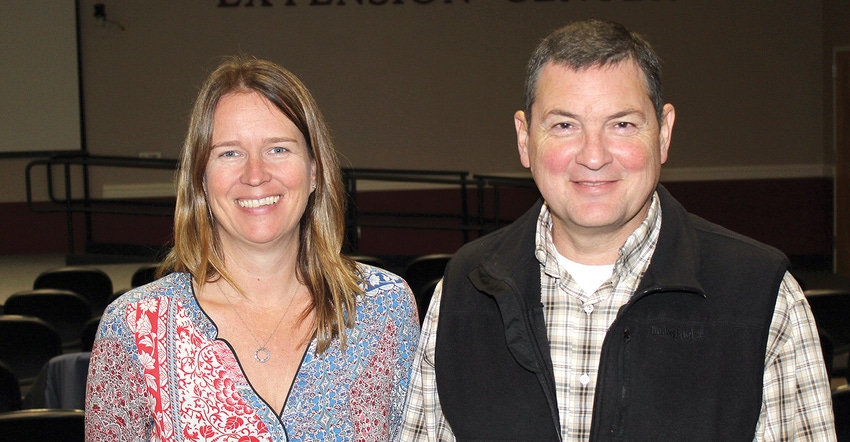February 2, 2017

Farmers in the Mississippi Delta have never really had to worry about the availability of ground water. Even when Mother Nature held back precipitation for extended periods, challenging dryland production, wells readily pumped seemingly endless volumes of water to farming irrigation systems.
Is the long-standing draw on the Mississippi River Valley Alluvial Aquifer sustainable? Will the area’s next generation of farmers have an adequate water supply for their operations?
Those questions and many more like them are being addressed by the Delta Sustainable Water Resources Task Force, a consortium of organizations that, since 2011, has been working to evaluate the aquifer’s current level, convince producers to establish more efficient irrigation practices, and educate them on the long-term importance of both.
Kay Whittington, director of the Office of Land and Water Resources at Mississippi’s Department of Environmental Quality (MDEQ), put the problem in perspective, saying, “The number of permitted ground water wells in the Delta has increased from slightly fewer than 3,000 in the 1980s, to over 19,000 today.”
Those wells in the late 1980s had a permitted volume of 900,000 acre feet per year. Today, 19,400 wells are permitted for 5.5 million acre feet per year.
The aquifer does recharge itself, but because of the high volume of water being drawn from it over decades, it cannot recharge fast enough to maintain a sustainable level moving forward — a level that has been declining steadily for over 30 years.
Land subsidence
Land subsidence, the gradual settling or sudden sinking of the Earth’s surface caused by movement in subsoil materials is, thankfully, not a problem in the Delta. It is in many parts of the country.
“The Delta draws from deeper aquifers for drinking water, so there’s no direct competition between water used for irrigation and water used for drinking,” explains Whittington.
Acknowledging the significance of the Delta’s water supply issue, Gov. Phil Bryant issued an executive order in 2014 formalizing the Task Force and instructing the member organizations to work collectively to devise solutions. The group’s guiding principles include: Manage water as efficiently as possible; store it when it is plentiful to use when it is not; and pursue every feasible alternative to attain aquifer sustainability.
Conservation, the group’s initial mantra, is something producers can implement easily, and can yield both immediate and significant benefits. Tailwater recovery systems, instream weirs, and possibly “intra-basin” transfers have the potential to encourage producers to use surface water where it is available instead of ground water.
“We’re also considering transferring ground water from a high volume area of the aquifer and injecting it to enhance recharge in an area where groundwater levels are lower. Strategically located weirs also have the potential to enhance recharge. The Task Force is considering all alternatives that hold potential,” adds Whittington.
Monitoring and Modeling
The U.S. Geological Survey, in collaboration with MDEQ and other Task Force organizations, has developed a comparative modeling analysis to illustrate how the aquifer would respond to the various suggested alternatives. Ag economists are comparing the costs of various alternatives from a per-unit of water provided or saved perspective, and pilot projects are being conducted to evaluate the feasibility of groundwater injection and its potential to enhanced aquifer recharge.
The largest water reduction pressure on the aquifer is pumpage from the 19,000 wells. A volunteer flow meter installation program for agriculture was initiated by MDEQ. Reports of metered water use for ten percent of the wells in each Delta county were submitted by the Feb. 1, 2016, deadline. To avoid a mandatory metering program, permit holders must continue to submit reports on 10 percent of the wells in each county by Feb. 1 of each year.
“We have received 1,872 water use reports to date. Of those, 60 percent were related to soybeans. Next, was corn, cotton, and finally rice. It’s pretty representative of the Delta’s crop distribution, and that helps because we must have good, reliable data to improve model accuracy — which will also take into account soil types and precipitation,” explains Whittington.
Only one county, Desoto, has met its 10 percent requirement for the February 2017 deadline. Of the 1,666 reports needed, MDEQ has received only 526, which puts them behind from where they were last year. If compliance is not achieved, mandatory metering and interrelated regulations could be implemented — which nobody wants, but was discussed when the Task Force made this agreement.
Efforts from the Task Force are geared toward improving and understanding information related to the inputs for the model, and ultimately recharging of the aquifer.
Collaboration, commitment
“The problem of the aquifer’s decline can only be solved through collaboration and a Delta-wide commitment from agriculture. I encourage all farmers to participate in the Voluntary Flow Meter Installation Program. Current water use levels are not sustainable, but we believe these conservation efforts can make a huge difference in both the environmental and economic sustainability of the Delta,” concludes Whittington.
To learn more about and participate in the Delta Metering Program, visit the MDEQ Web site https://www.deg.state.ms.us and click on the program’s link on the left side of the home page.
You May Also Like




